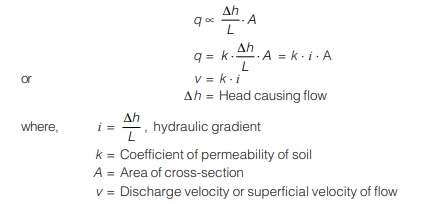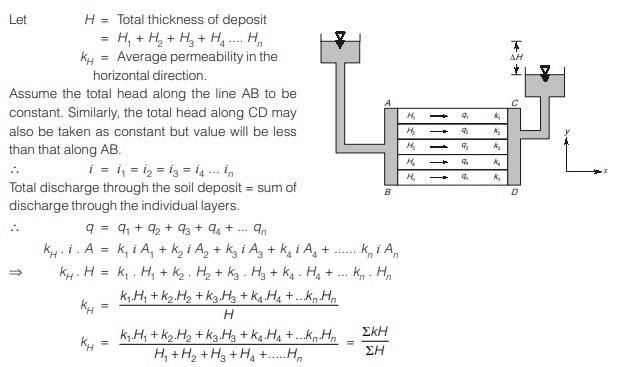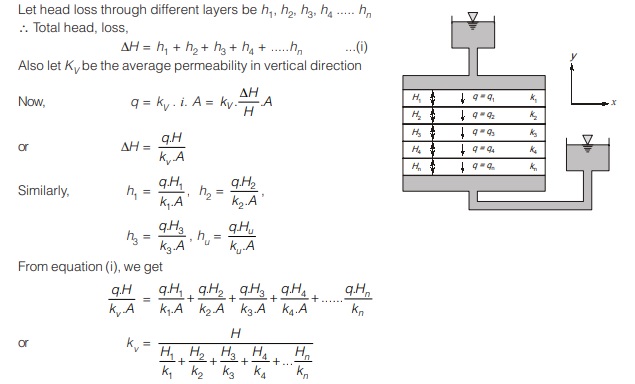Permeability of Soil
Soil is a particulate material and has pores that provides a passage for water. Such passages vary in size and are interconnected. The permeability of soil is a property which describes quantitatively, the ease with which water flows through that soil.
Darcy’s Law
The flow of free water through soil is governed by Darcy’s Law. Darcy established that the flow occurring per unit time is directly proportional to the head causing flow and the area of cross-section of the soil sample but is inversely proportional to the length of the sample, i.e.

FACTORS AFFECTING PERMEABILITY
The permeability depends on the soil properties and fluid properties both.
The Kozney-Carman equation is quite useful, it reflects the effect of factors that affect permeability.
![]()
(a) Grain Size:
The coefficient of permeability (k) includes D210 , where D10 is a measure of grain size.
i.e. k α D210
If the void ratio is same, then permeability is more in coarse soil than in fine soil.
lgravel > ksand > ksilt > kclay
(b) Void ratio:
• As per Kozeny-Carman equation, coefficient of permeability is directly proportional to e3 / 1+e
![]()
• If particle size is same, then loose soils are more permeable than dense soils.
• The plot of void ratio (e) against permeability k (at log scale) is approximately a straight line for all soils.
(c) Particle shape:
• It is expressed in terms of specific surface area and permeability relates to specific surface area.
k α 1 / S2
• The angular particles have greater specific surface than the rounded particles.
• For the same void ratio, the soils with angular particles are less permeable than those with rounded particles.
(d) Degree of Saturation:
Permeability is directly proportional to degree of saturation i.e k α Degree of saturation (S).
In partially saturated soils, entrapped air causes blockage in the flow of water. Hence, the permeability of partially saturated soil is lesser than that of a fully saturated soil.
(e) Entrapped air and gases:
Entrapped air and gases in the voids obstruct flow and cause the reduction of permeability.
As far as possible, sample should be fully saturated before the permeability test.
(f) Structure of Soil particles:
For stratified soils, permeability is more in horizontal direction as compared to the vertical direction.
(g) Properties of pore fluid:
The coefficient of permeability also includes γw/µ
i.e. k α γw/µ
For water, relatively the unit weight remain constant but viscosity (µ) decreases with increasing temperature.
i.e. µ α 1 / T
Hence, k α T
(h) Adsorbed water:
Adsorbed water or water film which is strongly attached to the soil solids, reduces flow area available for passage of water, which reduces permeability to some extent.
(i) Impurities:
Due to presence of impurities, voids are blocked and the permeability is reduced.
(j) Presence of minerals in water:
• The permeability of clay, depends upon the cation absorb on the surface of mineral.
• If void ratio is constant, the permeability is increased in the following order.
k < Na < H < Ca for montmorillonite
Na < k < Ca < H for K
• For the construction of core of earthen dams, the clay being treated with salt water (Na-water) so that seepage can reduced.
(k) Effect of effectiveness:
As effective stress increases, void ratio decrease and consequently permeability decreases.
PERMEABILITY OF STRATIFIED SOILS
In nature, soils are usually deposited in successive layers. Even if the different layers of the deposit are homogeneous within themselves, this may lead to a considerable disparity in the average permeability parallel to the bedding plane and that normal to the bedding planes.
Broadly, stratification can be considered as horizontal and continuous, average coefficient for flow in horizontal and vertical directions can be estimated.
Horizontal Flow
Consider the solid profile, shown in figure below consisting of n number of layers with H1, H2, H3 …. Hn in
thickness with their permeability k1, k2, k3 …… kn respectively.
Vertical Flow
In this case, flow takes place in the direction perpendicular to the stratification.
In this case, to satisfy the continuity condition,
q = q1 = q2 = q3 = q4 = …. qn

